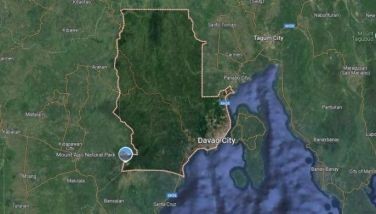New toxic bloom blamed for fishkill in Pangasinan
February 7, 2002 | 12:00am
BOLINAO, Pangasinan — A bloom of red-pigmented phytoplanktons, said to be occurring in the country for the first time, was blamed by marine biologists, among other factors, for the massive fishkill that destroyed about P400 million worth of bangus in this town.
In a statement, the University of the Philippines’ Marine Science Institute (UPMSI) identified the phytoplankton as Prorocentrum minimum which, it said, has caused human poisoning through shellfish consumption in other countries.
The UPMSI said the level of dissolved oxygen in municipal waters was way below the standard set by the Department of Environment and Natural Resources for the propagation of fish and other aquatic resources.
Such a low level of dissolved oxygen, according to the UPMSI, causes suffocation of gill-breathing aquatic organisms, which explains for the fishkill.
The UPSMI said the phytoplankton bloom and the low oxygen level may be attributed to the proliferation of fishcages and fishpens here, far exceeding the number set in a municipal ordinance.
These fishcages and fishpens, it said, release large amounts of organic material from unconsumed fish feeds and fecal material from the cultured fish, which, in turn, accumulate in the bottom of the water and deplete the level of dissolved oxygen.
The municipal council has passed a resolution declaring a state of calamity owing the extent of the fishkill.
In a letter to Gov. Victor Agbayani, DENR Undersecretary Manuel Gerochi, officer-in-charge of the Lingayen Gulf Coastal Area Management, expressed fears about the health and environmental risks which the sluggish disposal of decaying bangus poses.
"Conservatively, there are about 10 million pieces of rotting bangus floating along the coastal waters. We realize that time is of the essence and resources are inadequate," he said. — With Jose Rodel Clapano
In a statement, the University of the Philippines’ Marine Science Institute (UPMSI) identified the phytoplankton as Prorocentrum minimum which, it said, has caused human poisoning through shellfish consumption in other countries.
The UPMSI said the level of dissolved oxygen in municipal waters was way below the standard set by the Department of Environment and Natural Resources for the propagation of fish and other aquatic resources.
Such a low level of dissolved oxygen, according to the UPMSI, causes suffocation of gill-breathing aquatic organisms, which explains for the fishkill.
The UPSMI said the phytoplankton bloom and the low oxygen level may be attributed to the proliferation of fishcages and fishpens here, far exceeding the number set in a municipal ordinance.
These fishcages and fishpens, it said, release large amounts of organic material from unconsumed fish feeds and fecal material from the cultured fish, which, in turn, accumulate in the bottom of the water and deplete the level of dissolved oxygen.
The municipal council has passed a resolution declaring a state of calamity owing the extent of the fishkill.
In a letter to Gov. Victor Agbayani, DENR Undersecretary Manuel Gerochi, officer-in-charge of the Lingayen Gulf Coastal Area Management, expressed fears about the health and environmental risks which the sluggish disposal of decaying bangus poses.
"Conservatively, there are about 10 million pieces of rotting bangus floating along the coastal waters. We realize that time is of the essence and resources are inadequate," he said. — With Jose Rodel Clapano
BrandSpace Articles
<
>
- Latest
- Trending
Trending
Latest
Trending
Latest
Recommended





























